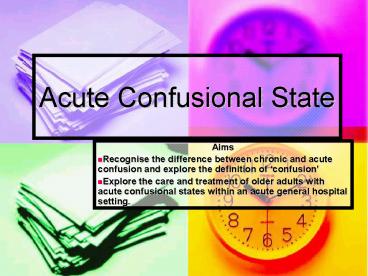Acute Confusional State - PowerPoint PPT Presentation
1 / 9
Title:
Acute Confusional State
Description:
Explore the care and treatment of older adults with acute ... Anaesthesia. Substance abuse and withdrawal. Pain & discomfort. Constipation. Risk Factors ... – PowerPoint PPT presentation
Number of Views:475
Avg rating:5.0/5.0
Title: Acute Confusional State
1
Acute Confusional State
- Aims
- Recognise the difference between chronic and
acute confusion and explore the definition of
confusion - Explore the care and treatment of older adults
with acute confusional states within an acute
general hospital setting.
2
Delirium in Older People
- Patients who develop delirium have high
complication - and mortality rates and longer lengths of stay in
- Hospital, (Young George 1999)
- Definition
- Delirium is characterised by disturbance of
- consciousness and a change in cognition
developing - over a short period of time.
- There is evidence that it is a direct consequence
of a - general medical condition, drug withdrawal or
- intoxication.
3
Assessment Diagnosis
- A patient must show all the following features in
order to make a diagnosis of delirium. - Disturbance of consciousness, inability to focus
or shift attention. - Change in cognition or development of perceptual
disturbance not accounted for by pre-existing
dementia. - The disturbance develops over a short period of
time and tends to fluctuate during the day. - Evidence that the condition is caused by direct
physiological consequences of a general medical
condition.
4
Diagnostic feature of Dementia Acute Confusion
- Dementia
- Impairment in short term
- memory.
- Impairment in abstract
- thinking, judgement, cortical
- functioning and personality
- change.
- Deficits are not caused by
- delirium.
- History physical examination
- indicate deficits are produced by
- a dementia or cannot be
- Accounted by anything else.
- Delirium
- Disturbance of consciousness.
- Reduced ability to focus sustain
- or shift attention.
- Change in cognition and
- development of perceptual
- disturbance.
- Evidence from history, physical
- examination or laboratory
- findings shows presence of
- general medical condition.
5
Common causes of Acute Confusion in Older People
- Infection
- Metabolic disorders
- Medications
- Multiple causes
- Dementia
- Anaesthesia
- Substance abuse and withdrawal
- Pain discomfort
- Constipation
- Risk Factors
6
Key issues during and following Acute Confusion
- Who is this person and usual presentation?
- What is their usual level of functioning?
- Appropriate communication be with them.
- Older people their carers may need to talk
- about what has happened to them.
- Fear that this might lead to a mental illness.
- Patients may benefit from a follow up in the
- Community.
- The rehabilitation process may be delayed.
7
Management of Confusion
- Good lighting, visible clues to orientation and
sensory aids, (newspapers, calendars,
photographs) - Explanation of procedures short simple
sentences. - Avoidance of inter intra-ward transfers.
- Approaching and handling gently.
- Maintenance of normal sleep pattern, ensure fluid
nutritional needs are met. - Encouraging relatives and friends to help create
a calming environment. - Continuity of care by staff.
- (Young George 1999)
8
(No Transcript)
9
Key Points to Remember !
- People with delirium often exhibit confused
- and muddled speech. It is preferable not to
- agree with confused communications, options
- could be
- Tactfully disagree.
- Change the subject.
- Acknowledge the feelings expressed whilst
- not confirming the confused perceptions or
- beliefs.
- Respect, Reassure, and Restore Calm

